List of mango cultivars
The following is a list of some prominent mango cultivars. Worldwide, hundreds of mango cultivars are known.
Most commercial cultivars belong to Mangifera indica, while a few commercial varieties grown in Southeast Asia belong to other Mangifera species.[1] Southeast Asia, Australia, the United States and some African countries cultivate locally selected varieties, while most other countries grow cultivars developed in Florida.[1]

Table of mangoes
Reportedly, in India alone, there are around 283 types of mangoes, out of which only 30 are well-known.[2][3][4] The United States Department of Agriculture (USDA) facility on Old Cutler Road in Coral Gables, Florida, has about 400 varieties of mangoes and is one of the largest depositories of mango plant cultures in the world. The USDA collection was originally believed to have over 500 varieties of mango germplasm, but genetic testing showed several duplicates. In the United States, South Florida is one of the meccas for mangoes due to year-round temperate climate and culture fascinated by mangoes and several nurseries dedicated to bringing new varieties of mangoes into the US by either import or selective breeding. Reviews of older varieties of mangoes were based upon the competition available at the time. Most of the varieties of mangoes available in grocery stores in the United States can trace their lineage to the Haden mango tree, a tree planted by Jack Haden in 1902 in Coral Gables, Florida (Haden itself can be traced back to Malgova which is misspelled Malgoba in US and has its origin in Tamil Nadu, India). The following are among the more widely grown mango cultivars, listed by the country in which they were selected or are most extensively cultivated:
| Common name(s) |
Image | Origin/ region |
Notes |
|---|---|---|---|
| Alampur Baneshan |  |
India | |
| Alice |  |
United States | |
| Alphonso |  |
India, Pakistan | "King of mangoes", very sweet with fibreless pulp, rich in vitamin A and C, found mainly in Devgad & Ratnagiri Districts of Maharashtra, India. This cultivar is available from February till the end of May. The dates of availability of mangoes vary by geography, climate, and weather. |
| Amrapali | .jpg.webp) |
India | Cross between Dasheri and Neelum mangoes. Considered among the better tasting mangoes with a strong aroma in its leaves. Fruits every year with no alternate bearing unlike other mangoes. |
| Anderson |  |
United States | Anderson is a seedling of Sandersha that was planted at the residence of Mrs. L.F. Anderson in Miami, Florida. Anderson is a large mango, growing in length from 26 to 34 cm. [Mangoes: A Guide To Mangoes In Florida, p. 30] The eating quality was listed as "fair." |
| Angie |  |
United States (Florida) | Angie mangoes are a dwarfing mango tree from Florida, rated highly for their taste. Angie has a resinous taste, similar to the Carrie mango. Angie is considered to be a disease-resistant mango, but in high humidity environments Angie's new leaf growth is susceptible to mango scab. |
| Anwar Ratol |  |
Pakistan (Punjab), India (Uttar Pradesh) | Anwar Ratol is a small sized yellow in colour mango sometimes known as mini-sized power house available in the Punjab and Sindh regions of Pakistan. It is also available near Rataul village in Uttar Pradesh, India. It is highly sweet in taste, with few fibres. |
| Ataulfo |  |
Brazil, Ecuador, Mexico | |
| Badami |  |
India (Karnataka) | Badami mangoes are also known as the Alphonso of Karnataka state. |
| Bailey's Marvel |  |
United States | |
| Banganapalle |  |
India (Andhra Pradesh) | It originates from the erstwhile princely state of Banganapalle, in present-day Andhra Pradesh and remains the most produced cultivar in the state.[5] It is obliquely oval in shape, around 20cm in length, with yellow flesh and a thin, smooth yellow skin. The flesh has a firm, meaty texture and is sweet and lacks fibre.[6][7] |
| Bangalora[8] | India | It is also known as Kilimooku mangoes | |
| Bennet Alphonso |  |
United States | |
| Beverly |  |
United States | Beverly is an almost fiber-less late season mango, grown in South Florida, fruiting between August and October. |
| Black and Rose |  |
India (Kerala) | Black and Rose |
| Bombay |  |
India, United States | Bombay is a vigorous mango tree that bears fruit in June–July in South Florida. It is susceptible to anthracnose. Bombay is the parent of the White Perie mango of Hawaii. |
| Brahm Kai Meu |  |
United States | |
| Brooks |  |
Australia, United States | |
| Carabao (Philippine Mango) | .jpg.webp) |
Philippines | The Ataulfo and Manilita mango cultivars originated from the Philippine Mango variety. It can be traced back in the Manila-Mexico galleon trade in the years 1600-1800s.[9] |
| Carrie |  |
United States | Carrie is a seedling of a Sophie Fry from the residence of Mr. Lawrence H. Zill of Boynton Beach, Florida. It was named in honor of Mr. Zill's mother, Carrie. The Carrie mango turns slight yellow when ripe, but what it lacks in color, it makes up in taste. The Carrie mango has a strong resinous flavor that is desired by some, and despised by others. A Carrie mango must be allowed to ripen on the tree and develops a strong "musky" flavor when over-ripe. |
| Chaunsa |  |
India, Pakistan | Chaunsa (also referred to as 'Chausa') is a pale yellow, slightly green succulent variety of mango when near ripe. Closer to its ripening, the mango skin will become slightly wrinkly and soft to the touch. Chaunsa is harvested in the summer months (June–September). |
| Chinna rasalu | India (Nuzvid, Andhra Pradesh) | ||
| Cherukurasamu | India (Nuzvid, Andhra Pradesh) | ||
| Coconut Cream | United States | Coconut Cream is part of the selective breeding program by Zills High Performance and is patented. The fruit tastes like coconut cream pie. The branches of the tree grow in arcs and curve around, making a complex tree canopy. | |
| Chok Anan | 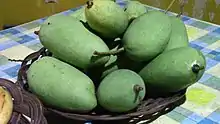 |
Pakistan, Bangladesh, India, Thailand | Choc Anan is known as the ever-bearing mango tree because of its potential to have a mango crop during the summer and winter. Some speculate that removing the summer crop may increase the chances of a winter crop by allowing the tree to save the energy that would have been used for fruit production in the summer. |
| Cogshall |  |
United States | Cogshall is from Pine Island, Florida. It is an excellent eating quality, but is not commercially available because of a very short shelf-life and thin skin that would bruise easily. |
| Cushman |  |
United States | |
| Dasheri |  |
India, Nepal, Pakistan | Grafts and propagations from a mother tree near Lucknow, Uttar Pradesh, India have been widely grown in North India, Nepal, Pakistan and as far south as Andhar Pradesh since the 18th century.
An excellent quality mango, it is grown for export, and can be found in markets around southeast Asia. |
| Dot |  |
United States | Dot is an exceptional tasting mango. Dot is a seedling of the Carrie Mango planted at Lawrence Zill's Boynton Beach, Florida home. The dot mango is highly susceptible to anthracnose, so it should not be planted in high humidity locations. |
| Dudhiya Malda, Malda or Maldeo | India (Bihar), Nepal | ‘Dudhia Malda’ mango of the Digha Ghat region of Patna, Bihar. It is also known as the King of Mangoes. Grown in Digha, Patna, Bihar, and Madhesh province. It is Best Known for its distinctively sweet, thin skin, small seeds, low fiber, milky yellow pulp and a unique sweet aroma[10][11][12][13]
This is a famous variety of mango cultivated in Bihar and is famously irrigated with milk. The specialty of Dudhiya Malda mango grown in Digha is further enhanced due to the soil here. The dry and fertile soil here plays an important role in the sweetness and aroma of Malda mango It is called Dudiya because once the skin of the mango is scratched milk-like liquid oozes out. With its thin skin, small seed, less fibre, milking yellow pulp, and unique sweet aroma, are considered among the best by connoisseurs. If Dussehri of Lucknow is the queen, then Malda of Digha is the "King of Mango".[10][11][12][13] | |
| Duncan |  |
United States | Duncan mango was patented by David Sturrock of West Palm Beach, Florida. The patent has long since expired. Duncan fruits in clusters and has excellent disease resistance. It is a mid-late season mango. |
| Earlygold | 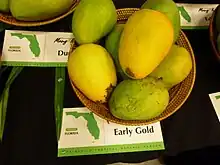 |
United States | |
| Edward |  |
United States | Edward is an excellent eating quality mango, but is considered to be a shy bearer (little fruit). |
| Eldon |  |
United States | |
| Emerald | United States | ||
| Espada | Brazil | ||
| Fazli (mango) |  |
Bangladesh (Rajshahi) | The 'Fazli' mango is a mango cultivar primarily grown in Bangladesh. and Indian States of West Bengal. It is a late maturing fruit, available after other varieties. Fazlis are commonly used in jams and pickles in the cuisine of the Indian subcontinent. Each mango can be quite large, going up to a kilo. Rajshahi in Bangladesh is the major producers of fazli. |
| Fajri Kalan | Pakistan | ||
| Fairchild |  |
United States | |
| Fascell |  |
United States | |
| Florigon |  |
United States | Florigon is a seedling of a Saigon planted on the property of Mr. John C. Kaiser, Fort Lauderdale, Florida. The Florigon tree is vigorous. Florigon is considered to be one of the most disease resistant varieties of mangoes in high humid climates, although the flavor is not on par with many of the newer varieties. |
| Ford | 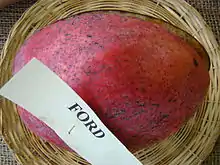 |
United States | |
| Gary |  |
United States | The Gary mango is considered delicious by many with a hint of coconut flavor. Gary is considered very susceptible to anthracnose. |
| Gir Kesar |
|
India, United Arab Emirates | The Gir Keshar mango is famous for its colour and smell. Ripe fruit gives a world's best smell and taste. The taste and smell makes them expensive. |
| Glenn |  |
Italy, United States | Glenn is a sweet, mild mango. The tree is vigorous, to a medium size. The canopy is rounded. The ripe fruit has a very pleasant sweet smell. |
| Golapkhas/Gulabkhas | India | ||
| Gold Nugget |  |
United States | |
| Golden Lippens | United States | ||
| Graham |  |
Trinidad | Graham is from Trinidad. Compared with many modern mangoes, Graham seems bland. |
| Green Willard | Sri Lanka, India | ||
| Haden |  |
India, Australia, Brazil, Costa Rica, Ecuador, Guatemala, Honduras, Mexico, United States | Haden is the "parent" of many, many other varieties of mangoes in the United States. Haden was a Mulgoba seedling. The original Haden tree still stands in Coral Gables, Florida. |
| Haribhanga |  |
Bangladesh | The Haribhanga mango is a mango cultivar produced in the northwest part of Bangladesh, especially in the Rangpur district. Cultivation of the Haribhanga mango has recently gained popularity among the farmers of northern districts. Locally called Haribhanga, these mangoes are round in shape and black in color. Haribhanga is highly fleshy, fiberless, and typically weighs 200 to 400 grams. |
| Hatcher | United States | ||
| Heidi | South Africa | ||
| Himayat / Imam Pasand |  |
India | |
| Himsagar |  |
India (West Bengal), Bangladesh (Rajshahi) | The Himsagar mango is a popular mango cultivar, originating in the modern-day Rajshahi in Bangladesh and state of West Bengal in India. Widely considered as the Champagne of mangoes, the inside of Himsagar is yellow to orange in colour and does not have any fibre. The fruit is medium-sized and weighs between 250 and 350 grams, out of which the pulp content is around 77%. It has a good keeping quality. It is also known as Khirsapati. |
| Ice Cream | United States | ||
| Irwin |  |
Australia, Costa Rica, United States, Taiwan, Japan (Okinawa) | In Japan this variety is marketed as Apple Mango. |
| Ivory |
 |
China | Also known as the Jingu Ivory mango, or Ivory mango, this long, thin mango is named for its resemblance to a young elephant's tusk. It has thin, smooth skin. The flesh contains very few fibre, and constitutes approximately 82 percent of the fruit. It was first introduced into Yunnan, China from Thailand in 1914. The actual tree that was the first to be imported still grows, and during one year produced almost 500 kg of fruit.[14] |
| Jacquelin | United States | ||
| Jakarta |  |
United States | |
| Jean Ellen |  |
United States | |
| Julie |  |
Caribbean | A colourful, oval shaped mango with almost flat sides. Has a sweet-tart flavour and a dwarf growth habit. Originated in the Caribbean and is still very popular throughout the region. Julie is a high fibre mango. |
| Kalepad | India (Andhra Pradesh) | ||
| Gir Kesar | India (Kachchh) | ||
| Katchamitha |  |
India, Philippines | Katchamitha originated from India, but has become one of the most common cultivars in the Philippines where it is commonly called the "Indian mango". It is commonly eaten while still green and crispy and has a mildly sweet taste. The flesh is fibrous when ripe compared to the native carabao mango.[15][16] |
| Keitt |  |
Australia, Brazil, Costa Rica, Ecuador, Italy, South Africa, United States | Keitt (pronounced "kit") is one of the latest season mangoes in South Florida (United States), with fruit into October. Backyard Keitts in South Florida regularly get to 2 pounds, and occasionally as large as 5 pounds. |
| Kensington Pride |  |
Australia, Italy, United States | |
| Kent |  |
Australia, Brazil, Ecuador, Guatemala, Honduras, Israel, Italy, Mexico, South Africa, United States | The original Kent tree still stands in Coral Gables, Florida (United States) |
| Kohu Amba | Sri Lanka | ||
| Kothapalli Kobbari | India (Pithapuram, Andhra Pradesh) | Also known as Kobbari Mamidi. | |
| Lakshmanbhog | India | ||
| Lancetilla |  |
Honduras, United States | Lancetilla can bear 5-pound fruit, but the eating quality is considered subpar among mango connoisseurs. The fruit is prone to splitting on the tree. |
| Langra |  |
India, Pakistan, Bangladesh | |
| Lemon Meringue | Myanmar | ||
| Lippens | 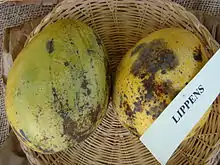 |
United States | |
| Madame Francis |  |
Haiti | Large kidney shaped mango that ripens to a golden yellow colour with piquant flesh Commonly exported to the United States in spring; often a feature of NYC fruit stands. Madame Francis is a high fiber mango. |
| Mahachanok | Asia, United States | Mahachanok is an oblong commercial mango from Asia, with yellow to orange color exterior when ripe. Described as a fiberless, sweet, and pleasant mango. The leaves of the tree are dark green and slimmer than many other mango trees. | |
| Mallika |  |
India, Nepal, United States | |
| Malwana (mango) | Sri Lanka | ||
| Manilita | United States | ||
| Manohar | India (Punjab) | Large mango that grows in clusters, seedling of Chaunsa. Exceptional complex flavor good sweetness. Very vigorous. | |
| Momi K[17] | Hawaii, United States | Teardrop shaped with a narrow point. Ripens to a reddish orange blush. Flesh has creamy consistency. | |
| Muhammad Wala | Pakistan | ||
| Mulgoba |  |
India, United States | Small mango with a comparatively big seed. Parent of the Haden mango. |
| Nam Doc Mai |   |
Thailand, United Arab Emirates | Fruit is elongated, with a prominent beak, and is normally yellow with green spots. |
| Neelam |  |
India, Pakistan | Weighing 9 to 12 oz, with the general shape of a fat cashew nut, Neelam are smooth-skinned and bright yellow upon ripening and have no blush. The flesh is deep yellow to orange, with no fibres and a rich, aromatic flavor that may overpower an unaccustomed palate. They have a late ripening season and can be stored for an extended time. Fruit should be harvested when mature green and ripened at room temperature off the tree. |
| Osteen |  |
Italy, Spain, United States | |
| Owais | Egypt | ||
| Paige | |||
| Palmer |  |
Australia, Brazil, United States | |
| Panakalu | India (Andhra Pradesh) | ||
| Panchadharakalasa | India (Andhra Pradesh) | It is a juicy variety and owes its origin to the East Godavari district of Andhra Pradesh . The name is derived from the Telugu words Panchadara , meaning sugar, and kalasa , meaning a pot . | |
| Paraíso | Mexico | ||
| Parvin |  |
United States | |
| Piña Colada | United States | Piña Colada is part of the selective breeding program by Zills High Performance. Piña Colada is a small fruit that packs a lot of flavor. The tree is unproductive and susceptible to anthracnose. | |
| Peddarasamu | India (Nuzvid, Andhra Pradesh) | ||
| Philippine | See Carabao (mango). | ||
| Pickering | |||
| Pico | 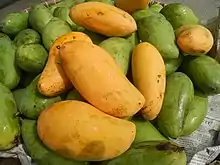 |
Philippines | Along with the Carabao mango, it is one of the most commonly cultivated mango cultivars of the Philippines. Elongated fruits with prominent beak. Light orange when ripe. Flesh rich orange to red. Sweet, fairly acidic, with short fibers. |
| Pim Seng Mun | |||
| Pineapple Pleasure | |||
| Po Pyu Kalay | Myanmar | ||
| Pram Kai Mea | See Brahm Kai Meu. | ||
| Raspuri |  |
India (Karnataka) | An extremely popular variety in South India, a fully ripe Raspuri (Rasa in Kannada means Juice) can produce a significant amount of juice per mango. |
| Red Willard | Sri Lanka | ||
| Rosa | Brazil | Rosa ("pink") mango is a variety found more easily in Northeast Region of Brazil, also known as 'Rosa da Bahia' or 'Rosa de Pernambuco'. Because it is very sweet but also very fibrous, it is mostly used to prepare juices or desserts in which it will be crushed. | |
| Rosigold |  |
United States | Rosigold is among the earliest season mangoes in South Florida. The quality is considered average, but at a time of year when there are no fresh mangoes, it is in its own class. Rosigold is susceptible to anthracnose. |
| Ruby |  |
United States | |
| Ryan | |||
| Saigon |  |
United States | |
| San Felipe |  |
Cuba | Fruit is large at 20 ounces with a striking oxblood color; the flesh is yellow. |
| Saharni | Pakistan | ||
| Sammar Bahisht | Pakistan, India | (in Urdu Sammar means fruit and Bahisht means Paradise) | |
| Sensation |  |
South Africa, United States | |
| Shan-e-Khuda |  |
Pakistan | |
| Sindhri | 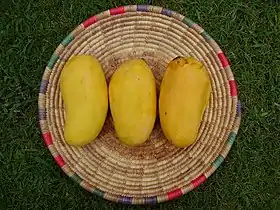 |
Mirpur Khas district, Sindh province of Pakistan | Significantly aromatic and sweet, the flesh of the Sindhri is soft, slick, and orange when fully ripe. Although many enjoy it as is, other consumers find the Sindhri wanting in sourness and may wish to eat it before it is fully ripe. |
| Sophie Fry |  |
United States | |
| Southern Blush | United States | ||
| Spirit of '76 | United States | Spirit of 76 is a seedling from Lawrence Zill's residence. The mango is fiberless and has a very pleasant sweet flavor. | |
| Springfels |  |
United States | One of the older cultivars from Florida, but still good tasting. It is a large mango, but Due to its size it has uneven ripening. The uneven ripening is known as "jelly seed," where the flesh around the seed is overripe and soft. |
| Sunrise | |||
| Sunset |  |
United States | |
| Swarnarekha | India (Andhra Pradesh) | ||
| Sweet Tart | |||
| Tess Pollok | |||
| Tommy Atkins |  |
Brazil, Costa Rica, Ecuador, Guatemala, Honduras, Israel, Italy, Mexico, South Africa, United Arab Emirates, United States, Venezuela | One of the most commonly sold mangoes in the world. has extremely long shelf life. Hard and oblong exterior. |
| Torbert | United States | ||
| Totapuri |  |
India | |
| Turpentine |  |
United States | Turpentine is a small, high fiber mango that is poly embryonic mango. Turpentine is used as a rootstock in Florida for grafting other mango varieties. |
| Ugly Betty | |||
| Valencia Pride |  |
South Africa, United States | Large, oblong mango. Sweet, mild flavor, but the fruit is prone to splitting on the tree. The tree is a vigorous grower. |
| Van Dyke |  |
Italy, United States | |
| Vellai Kolomban | Sri Lanka | ||
| Young | United States | Young mango was renamed the "Tebow" (after the American football player) for marketing purposes. | |
| Zill |  |
South Africa, United States | Zill is a seedling of Haden planted in 1922 by Carl King of Lake Worth, Florida (US). Vigorous tree, fruit is good eating quality. |
List of cultivars by nation
Asia
- Bangladesh: Amrapali, Haribhanga, Himsagar (also known as Kshirshapat) or Kshirshapati), BARI-4, Langra, Chokanan, BARI-11, Mahachanok, Gaurmati, BARI-13, Mallika, Sindoori, Gopalbhog, Gobindobhog, Brindabani, Gulabkhash, Ranipchanda, Lakhkhonbhog (also known as Lakhna or Guti), Fazli, Mohanbhog, Ashwina, BARI-3, BARI-1, BAU-23, BAU-24, BAU-14 (also known as banana mango)
- Cambodia: Cambodiana
- China: Baiyu, Guixiang, Huangpi, Huangyu, Macheco, Sannian, Yuexi
- India: Priyoor mango, Alphonso,[18] Amrapali, Alampur Baneshan, Badshahpasand, Bangalora, Banganapalle,[18] Black and Rose, Bombay, Bombay Green, Badami, Chausa, Cheruku Rasalu, Chinna rasalu, Chitoor, Rumani, Maharaja Pasand, Chinnarasam, Unda manfa, Dasheri, Dudhiya Malda, Ela Manga, Gaddamar, Gadam Mary, Fajri Kalan, Fernandian, HusanNara, Gulabkhas, Himayath, Himsagar, Imam Pasand,[18] Imam Hussain Mango, Jehangir, Surkha, Kalepad, Kishen Bhog, Komanga, Kothapalli Kobbari, Kuttiyattor, Kalami, Gir Kesar, Lalbaug, Langra Benarsi, Maldah, Malgis, Malgoa,[18] Mankur (Goa), Mallika, Mankurad, Mercury, Moovandan, Nagulapalli Rasalu, Nasik Pasand, Nattuma, Nannari, Neelum, Neeleshan, Ottu Mangai, Panchadara Kalasa, Panduri Mamidi, Payri, Pedda Rasalu, Priyor, Puliyan, Rani, Rajapuri, Raspuri, Ratna, Rayal Special, Safeda, Sammar Bahisht, Suvarnarekha, Thalimango, Totapuri, Vanraj, Yahya Mariam Mango, Zardalu, Nuzividu Rasalu.
- Indonesia: Arumanis/Harumanis, Gadung/Gedong, Manalagi, Mangga Madu, Cengkir/Indramayu, Gajah, Bapang, Lalijiwo, Kueni, Golek, Kemiri, Boled, Bengkulu, Situbondo, Kelapa, Alor, Selaputih, Kedundang
- Republic of Korea (Jeju Island, Jeollanam-do, Chungcheongnam-do, Gyeongsangnam-do, Gyeonggi-do): Apple mango, Irwin, Zillate
- Japan (Okinawa): Irwin
- Malaysia: Apple Mango, Apple Rumani, Arumanis, Golek, Kuala Selangor, Malgoa, Maha-65, Tok Boon
- Myanmar: Aung Din (အောင်ဒင်), Ma Chit Su (မချစ်စု), Po Pyu Kalay, Sein Ta Lone (စိန်တစ်လုံး), Shwe Hin Tha (ရွှေဟင်္သာ)
- Nepal: Alphonso, Amrapali, Dusehri, Bombay, Mallika, Pharsi aamp, Supadi aamp, Sindure aamp and other local cultivars.
- Pakistan: Almaas, Alphonso, Anmol, Anwar Rataul, BaganPali, Chaunsa, Chok Anan, Collector, Dusehri, Desi Ada Pamato, Desi Badam, Desi Gola, Desi Badshah, Dilkash, Fajri, Gulab Janhu, Gulab Khas, Lahoti, Lal Badshah, Langra, Malda, Muhammad Wole, Nawab Puri, Neelum, Rani Phool, Sindhri, Saroli, Sawarnarika, Saleh Bhai, Saib, Shan-e-Khuda, Taimuria, Toofan, Wanghi, Zafran
- Philippines: Apple mango, Carabao (Kinalabaw), Kabayo (Cabayo), Katchamitha ("Indian"), Pico (Padero), Paho, Pahohutan
- Singapore: Apple Mango, Arumanis, Golek, Kaem Yao, Mangga Dadol
- Sri Lanka: Dampara, Hingurakgoda, Karutha Kolomban, Malwana[under-ground] amba, Parrot Mango and Peterpasand, Petti amba, Rata amba, Vellai Kolomban, Wild Mango, Willard, Mee Amba, Kohu Amba, Pol Amba, Giraa amba, Red Willard, Green Willard, Mallika, TJC Mango.
- Taiwan: JinHwang, Red JinHwang, TaiNong No. 1, Irwin
- Thailand: Selected Mango varieties in Thai alphabet order.
- ก: แก้ว 007 Kaeo 007, กระแตลืมรัง Kratae Luemrang, กระสวย Krasuay, กล้วย Kluay, กะล่อนทอง Kalonthong, การะเกด Karaket, กาละแม Kalamae, กำปั่น Kampan, แก้มแดง Kaemdaeng, แก้วขาว Kaeo Khao, แก้วเขียว Kaeo Khieo, แก้วทวาย Kaeo Tawai, แก้วลืมคอน Kaeo Luemkon, แก้วลืมรัง Kaeo Luemrang, แก้วสามปี Kaeo Sampi, แก้วหอม Kaeo Hom.
- ข: ขอช้าง Khochang, ขายตึก Khaituek, ขี้ใต้ Khitai, ขี้ทุบ Khithup, ขุนทิพย์ Khunthip, เขียวไข่กา Khiaokhaika, เขียวภูเก็ต Khiaopuket, เขียวเสวย Khiaosawoey, เขียวเสวยรจนา Khiaosawoey Rotchana, ไขตึก Khaituek.
- ค: คล้ายเขียวเสวย Khlay Khiaosawoey, คอนกแก้ว Khonokkaeo, ค้างคาวลืมรัง Khangkao Luemrang, คำ Kham, คุ Ku.
- ง: งาขาวหรืองาหม่นยาว Nga Khaomonyao, งาเขียว Nga Khiao, งาช้าง Nga Chang, งาดาบ Nga Dap, งาแดง Nga Daeng, งาท้องเรือ Nga Thongruae, งาหม่น Nga Mon, เงาะ Ngo.
- จ: จันทร์เจ้าขา Chanchaokha, จำปา Champa, เจ้าคุณทิพย์ Chaokhunthip, เจ้าพระยา Chaopraya, เจ้าเสวย Chaosawoey.
- ช: ช้างตกตึก Changtoktuek, โชคโสภณ Chok Sopon, โชคอนันต์ Chok Anan, โชคอนันต์ก้านชมพู Chok Anankanchompu.
- ต: ตลับนาค Talapnak, ตะเพียนทอง Tapianthong, ตับเป็ด Tuppet, ตาเตะหลาน Ta Te-Lan, แตงกวา Thaeng Kwao.
- ท: ทวายเดือนเก้า Thawai Dueankao, ทองขาว Thongkhao, ทองขาวกลม Thongkhaoklom, ทองขาวยาว Thongkhaoyao, ทองเจ้าพัฒน์ Thongchaopat, ทองดำ Thongdam, ทองดำกลายพันธุ์ Thongdam Klaipan, ทองดำมีร่อง Thongdam Mirong, ทองแดง Thongdaeng, ทองทวาย Thongthawai, ทองประกายแสด Thongprakaisat, ทองปลายแขน Thongplaikhean, ทองไม่รู้วาย Thongmairuwai, ทุเรียน Thurian, ทูลถวาย Thunthawai, เทพนิมิตร Thepnimit, เทพรส Thepparot.
- น: นวลจันทร์ Nuanchan, นวลแตง Nuanthaeng, นาทับ Nathap, น้ำดอกไม้ Nam Doc Mai, น้ำดอกไม้ทวาย Namdokmai Thawai, น้ำดอกไม้เบอร์ 4 Namdokmai No.4, น้ำดอกไม้เบอร์ 5 Namdokmai No.5, น้ำดอกไม้พระประแดง Namdokmai Phrapradaeng, น้ำดอกไม้สีทอง Namdokmai Sithong, น้ำดอกไม้สุพรรณ Namdokmai Suphan, น้ำตาลจีน Namtan Chin, น้ำตาลเตา Namtan Tao, น้ำตาลปากกระบอก Namtan Pakkrabok, น้ำตาลทรายหนัก Namtansainak, น้ำผึ้ง Nampueng.
- บ: บานเย็น Banyen, บุญบันดาล Bunbandan, เบา Bao.
- ผ: ผ้าขี้ริ้วห่อทอง Pakhirio Hothong.
- พ: พญาลืมเฝ้า Payaluemfao, พญาเสวย Payasawoey, พรวนขอ Phruankho, พราหมณ์ก้นขอ Phram Konkho, พราหมณ์เนื้อแดง Phram Nueadaeng, พราหมณ์เนื้อเหลือง Phram Nuealueang, พัดน้ำผึ้ง Phatnampueng, พิมเสนกลายพันธุ์ Phimsen Klaipan, พิมเสนแดง Phimsen Daeng, พิมเสนเปรี้ยว Phimsen Preow, พิมเสนมัน Phimsen Man, เพชรบ้านลาด Phetbanlat.
- ฟ: ฟ้าลั่น Falan, ฟ้าแอปเปิล Fa-apple, แฟบ Faep.
- ม: มนโฑ Monto, มะปราง Maprang, มะลิลา Malila, มันบางขุนศรี Manbangkhunsi, มันค่อม Mankom, มันทวาย Manthawai, มันทวายนักรบ Manthawai Nakrop, มันทองเอก Manthong Aek, มันทะลุฟ้า Manthalufa, มันบ้านลาด Manbanlat, มหาชนก Mahachanok, มันพิเศษ Manpiset, มันสะเด็ด Mansadet, มันสายฟ้า Mansaifa, มันหมู Manmu, มันหยด Manyot, มันหวาน Manwan, มันแห้ว Manhaeo, มันอยุธยา Man Ayuthaya, เมล็ดนิ่ม Maletnim, แม่ลูกดก Maelukdok, แมวเซา Maeosao.
- ย: ยายกล่ำ Yaiglam.
- ร: รจนา Rotchana, ระเด่นขาว Radenkhao, ระเด่นเขียว Radenkhiao, แรด Raet.
- ล: ล่า La, ลิ้นงูเห่า Lin Nguhao, ลูกกลม Lukklom, ลูกแดง Lukdaeng, ลูกโยนพระอินทร์ Lukyon Phra-in, เล็บมือนาง Lepmuenang.
- ศ: ศาลายา Salaya.
- ส: สังขยา Sangkhaya, สามปี Sampi, สามฤดู Samruedu, สายทิพย์ Saithip, สายน้ำค้าง Sainamkang, สายฝน Saifon, สาวน้อยกระทืบหอ Saonoi Kratuepho, สำปั่น Sampan, สีส้ม Sisom, แสงทอง Saengthong.
- ห: หงษ์ทอง Hongthong, หงษ์สา Hongsa, หงสาวดี Hongsawadi, หนองแซง Nongsaeng, หนังกลางวัน Nangklangwan, หมอนทอง Monthong, หวานน้ำผึ้ง Wannampueng, หอยแครง Hoikrang, หอระฆัง Horakang, หินทอง Hinthong, แห้ว Haeo, แห้วหลวงอิงค์ Haeo Luanging.
- อ: อกร่อง Okrong, อกร่องกะทิ Okrong Kati, อกร่องขาว Okrong Khao, อกร่องเขียว Okrong Khiao, อกร่องทอง Okrong Thong, อกร่องทองดำกลายพันธุ์ Okrong Thongdamklaiphan, อกร่องไทรโยก Okrong Saiyok, อกร่องพิกุลทอง Okrong Phikunthong, อกร่องภรณ์ทิพย์ Okrong Phonthip, อกร่องมัน Okrong Man, อกร่องหอมทอง Okrong Homthong, อ่อนมัน Onman, อินทรชิต Inthorachit, ไอ้ฮวบ Ai-Huap
- Vietnam: Cao Lãnh Cát Chu mango, Bình Định Elephant mango, Hoà Lộc Sand mango
Oceania
- Australia:[19] B74 (known by the brand name Calypso), Brooks, Green eating, Haden, Irwin, Keitt, Kensington Pride, Kent, Nam Doc Mai, Palmer, R2E2, Honey Gold.
- Hawaii: Hawaiian Common, Gouveia, Hawaiian Dwarf, Kurahige, Mapulehu, Momi K, Pope, Rapoza, Sugai, Turpentine
Africa
- Cameroon: Améliorée du Cameroun
- Egypt: Alphonso, Hindi, Hindi Besennara, Beid El Agl, Oweisi, Fuss Oweis, Taymoor, Zebdiah, Mesk
- Kenya: Apple Mango,[20] Batwi, Boubo, Ngowe

- Mali: Amelie, Kent
- Réunion island: Carotte, Jose, Lucie, Auguste
- South Africa: Fascell, Haden, Keitt, Kent, Sensation, Tommy Atkins, Zill
- Sudan: Alphonso, Bez el-Anza, Oweisi, Taymoor
- Tanzania: Boribo Muyini, Dodo, Mawazo, Sindano
- Zambia: Heidi, Kent, Sensation, Tommy
Americas
- Brazil: Coquinho, Haden, Espada, Espada de Ouro, Keitt, Kent, Rosa, Palmer, Tommy Atkins
- Costa Rica: Haden, Irwin, Keitt, Mora, Tommy Atkins
- Cuba: San Felipe, Prieto, Toledo
- Ecuador: Ambassador, Alphonso, Ataulfo, Criollos, Haden, Julie, Keitt, Kent, Reina, Tommy Atkins
- Guatemala: Haden, Kent, Tommy Atkins
- Haiti: Francine (Madame Francis), Muscas, Labiche, Baptiste, Rosalie, Poirier, Corne, Fil
- Honduras: Haden, Kent, Lancetilla, Tommy Atkins
- Mexico: Ataulfo, Haden, Irwin, Kent, Manila, Palmer, Sensation, Tommy Atkins, Van Dyke, Petakon, Oro, Criollo, Niño, Miyako.
- Peru: Criollos, Haden, Keitt, Kent, Tommy Atkins
- Suriname: Rood borsje, Tetéé
- United States (California): Keitt, Haden, Timotayo, Manila
- US (Florida): Alampur Baneshan, Alice, Alphonso, Anderson, Angie, Bailey's Marvel, Bennet Alphonso, Beverly, Bombay, Brahm Kai Meu, Brooks, Carabao, Carrie, Chok Anan, Cogshall, Cushman, Dot, Duncan, Earlygold, East Indian, Edward, Eldon, Emerald, Fairchild, Fascell, Florigon, Ford, Gary, Gaylour, Glenn, Gold Nugget, Golden Lippens, Graham, Haden, Hatcher, Ice Cream, Irwin, Ivory, Jakarta, Jean Ellen, Julie, Keitt, Kensington Pride, Kent, Lancetilla, Langra Benarsi, Lippens, Mallika, Manilita, Mendoza, Mulgoba, Nam Doc Mai, Nam Tam Teen, Neelum, Nu Wun Chan, Okrung, Osteen, Palmer, Parvin, Pascual, Philippine, Pickering, Po Pyu Kalay, Rosigold, Ruby, Rutledge, Saigon, Sensation, Sophie Fry, Southern Blush, Spirit of '76, Springfels, Sunset, Suwon Tip, Tebow, Toledo, Tom Dang, Tommy Atkins, Torbert, Turpentine, Valencia Pride, Van Dyke, Zill
- Venezuela: Haden, Keitt, Kent, Tommy Atkins
- West Indies: Amélie, Black (blackie), Bombay, Dou-douce, East Indian, Graham, Haden, Julie (St. Julian), Long, Madame Francis, Rose, Spice-Box, Starch
Europe
- Malta: Keitt, Maya, Kensington Pride, Glenn, Irwin
- Italy: Kensington Pride, Glenn, Tommy Atkins, Keitt, Maya, Van Dyke, Osteen, Kent[21]
Middle
- Egypt: Zebda , Mesk , Awais , Qalb el tor, Mabrouka , Sennara, Taymour.
- Israel: Haden, Omer, Orly, Shelley, Keitt, Kent, Maya, Nimrod, Palmer, Tommy Atkins, BD-4-98, Zrifin, Palmer, Naomi,King David.
- Yemen:[22] Taimoor, Abu Sanarah, Hafoos, Al Fawnas, Al Bameli, Al Burkani, Sudanese, Abu Samakah[23]
See also
References
- Litz, Richard E., ed. (2009). The Mango: Botany, Production and Uses (2nd ed.). CABI. pp. 68–70. ISBN 978-1-84593-489-7.
- "Treat yourself to mangoes on Jayamahal Road". Archived from the original on 2016-06-23. Retrieved 2016-05-26.
- "Top 10 Different Types Of Mangoes Grown In India". 14 May 2015. Archived from the original on 23 May 2016. Retrieved 26 May 2016.
- "King of Fruits Mango and Its Top Varieties Of Mangoes in India". Aam Walla. 2021-06-14. Archived from the original on 2021-06-24. Retrieved 2021-06-17.
- Correspondent, Special. "Banginapalli mango to get geographical indication". The Hindu. Archived from the original on 22 September 2020. Retrieved 5 May 2017.
- Pradeepkumar, T.; Suma Jyothibhaskar, B.; Satheesan, K.N. (2008), Management of Horticultural Crops, New Delhi, India: New India Publishing Agency, pp. 96–97
- "Buy Organic fresh Bangalora/KiliMooku/Totapuri Mangoes online direct from farms - Salem Mango". www.salemmango.com. Archived from the original on 2018-04-17. Retrieved 2018-04-17.
- "Manila Super Mango (Philippine Mango), the world's sweetest mango". Archived from the original on January 14, 2016. Retrieved May 7, 2015.
- "Digha Ghat's Dudhiya Malda considered 'King of Mangoes' in Bihar". dna. 2015-05-26. Archived from the original on 2016-06-18. Retrieved 2016-06-20.
- "All that you wanted to know about mangoes". The Telegraph. Archived from the original on June 9, 2013. Retrieved 2016-06-20.
- "Dudhiya Malda – FoodsOnStreet". foodsonstreet.wordpress.com. 25 April 2016. Archived from the original on 2016-10-13. Retrieved 2016-06-20.
- "Agriculture Market News Information from APEDA AgriExchange". agriexchange.apeda.gov.in. Archived from the original on 2016-08-17. Retrieved 2016-06-20.
- "Jinggu "Ivory" Mango-Yunnan Tourism Website". En.ynta.gov.cn. Archived from the original on 2014-04-21. Retrieved 2014-03-21.
- Mango Varieties (PDF). Agricultural Training Institute, Department of Agriculture, Republic of the Philippines. 2005. Archived (PDF) from the original on 2016-07-03. Retrieved 2019-01-13.
- "Katchamitha Mango". Research Development Extension. University of the Philippines Los Baños. Archived from the original on 13 January 2019. Retrieved 13 January 2019.
- "Mango General Information". Archived from the original on 2015-09-05. Retrieved 2015-04-12.
- "Mango varieties". The Hindu. 2005-01-27. p. 15. Archived from the original on 2005-03-27. Retrieved 2016-04-13.
- "Australian Mangoes - Australian Varieties". Mangoes.net.au. Archived from the original on 2015-09-01. Retrieved 2014-03-21.
- "Mukuyu farm, 20ha of commercial land in Ukambani| Kibwezi river". Better Globe Forestry. Archived from the original on 2015-08-10. Retrieved 2014-03-21.
- http://www.freshplaza.it/images/2010/1220/coltivazione_del_mango_in_Sicilia.pdf Archived 2016-03-04 at the Wayback Machine
- Thomas, Edward (8 March 2022). "Food security in Yemen: the private sector and imported food". ODI. ODI. Archived from the original on 26 May 2022. Retrieved 17 May 2022.
- حلم أخضر, حلم أخضر. "اليمن: 200 سنة من زراعة فاكهة المانجو" (in Arabic). حلم اخضر. Archived from the original on 6 March 2023. Retrieved 17 May 2022.
